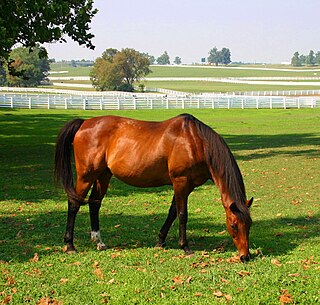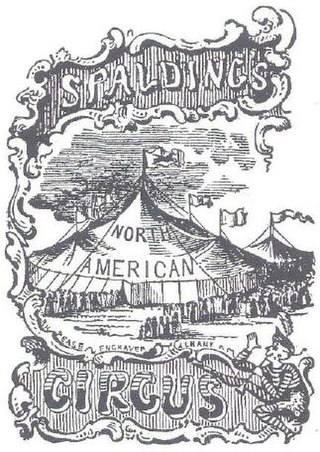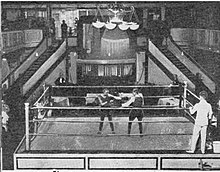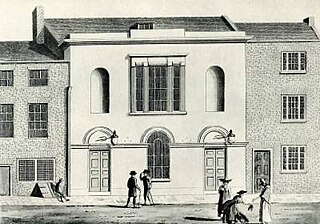
Philip Astley was an English equestrian, circus owner, and inventor, regarded as being the "father of the modern circus". Modern circus, as an integrated entertainment experience that includes music, domesticated animals, acrobats, and clowns, traces its heritage to Astley's Amphitheatre, a riding school that Astley founded in London following the success of trick-riding displays given by him and his wife Patty Jones in 1768. Astley's first competitor was equestrian Charles Hughes, who had previously worked with Astley. Together with Charles Dibdin, a famous author of pantomimes, Hughes opened a rival amphitheatre in London, which Dibdin called the Royal Circus and Equestrian Philharmonic Academy.

Kentucky Horse Park is a working horse farm, international equestrian competition venue, and an educational theme park opened in 1978 in Lexington, Kentucky. It is located off Kentucky State Highway 1973 and Interstate 75, at Exit 120, in northern Fayette County in the United States. The equestrian facility is a 1,224-acre (4.95 km2) park dedicated to "man's relationship with the horse." Open to the public, the park has a twice daily Horses of the World Show, showcasing both common and rare horses from around the globe. The horses are ridden in authentic costume. Each year the park is host to a number of special events and horse shows.

An auditorium is a room built to enable an audience to hear and watch performances. For movie theatres, the number of auditoria is expressed as the number of screens. Auditoria can be found in entertainment venues, community halls, and theaters, and may be used for rehearsal, presentation, performing arts productions, or as a learning space.

The Theatre Royal is a historic theatre, a Grade I listed building situated on Grey Street in Newcastle upon Tyne.
The Bowery Amphitheatre was a building in the Bowery neighborhood of New York City. It was located at 37 and 39 Bowery, across the street from the Bowery Theatre. Under a number of different names and managers, the structure served as a circus, menagerie, theatre, a roller rink, and a branch of the Peniel Mission. The site is now part of Confucius Plaza.

The Princess Theatre, originally Princess's Theatre, is a 1452-seat theatre in Melbourne, Victoria, Australia. Established in 1854 and rebuilt in 1886 to a design by noted Melbourne architect William Pitt, it is the oldest surviving entertainment site on mainland Australia. Built in an elaborate Second Empire style, it reflects the opulence of the "Marvellous Melbourne" boom period, and had a number of innovative features, including state of the art electric stage lighting and the world's first sliding ceiling, which was rolled back on warm nights to give the effect of an open-air theatre.

Astley's Amphitheatre was a performance venue in London opened by Philip Astley in 1773, considered the first modern circus ring. It was burned and rebuilt several times, and went through many owners and managers. Despite no trace of the theatre remaining today, a memorial plaque was unveiled in 1951 at its site at 225 Westminster Bridge Road.

Bridlington Spa is a dance hall, theatre and conference centre in Bridlington, East Riding of Yorkshire, England. Refurbished between 2006 and 2008 and further updated with a new branding in 2016, the venue boasts a large Art Deco ball room, Edwardian theatre, art gallery and a selection of other meeting and event spaces; all featuring outstanding views over Bridlington's South Bay.

The Amphitheatre of Pompeii is one of the oldest surviving Roman amphitheatres. It is located in the ancient city of Pompeii, near Naples, and was buried by the eruption of Vesuvius in 79 AD, that also buried the city of Pompeii and the neighbouring town of Herculaneum.

Hippodrama, horse drama, or equestrian drama is a genre of theatrical show blending circus horsemanship display with popular melodrama theatre.

Roman amphitheatres are theatres — large, circular or oval open-air venues with raised seating — built by the ancient Romans. They were used for events such as gladiator combats, venationes and executions. About 230 Roman amphitheatres have been found across the area of the Roman Empire. Early amphitheatres date from the Republican period, though they became more monumental during the Imperial era.

The Lessing Theater was a theatre in the Mitte district of Berlin, Germany. It opened in 1888 and was destroyed in April 1945 in a bombing raid; its ruins were demolished after World War II.

Cooke's Royal Circus (1780–1912) started as a circus show travelling around Britain in the late 18th century. It was primarily an equestrian show with over half the acts involving horses.

The Prince's Theatre was a theatre on Park Row in Bristol in England which was built in 1867 and was destroyed by bombing in 1940 in the Bristol Blitz during World War II. Owned by members of the Chute family for most of its existence, at one time the theatre was the Bristol venue for many of the country's leading touring actors and theatrical companies in addition to being one of the most renowned pantomime houses in the country before briefly becoming a music hall and latterly a cinema. The actors Henry Irving and Ellen Terry made their last appearance together under Irving's management at the Prince's Theatre in The Merchant of Venice in 1902.

"Dr." Gilbert Reynolds Spalding, sometimes spelled Spaulding, was an American showman, circus owner and innovator, being the first to own his own showboat, constructed the first showboat to contain an entire circus and in 1856 the first to send an entire circus on tour in its own railroad cars.

The Hippotheatron was an entertainment venue in New York built for large-scale circus and equestrian performances although ballets, dramas and pantomimes were also held there. Opened in 1864, it was destroyed by fire in 1872 which resulted in the death of most of the animals in the menagerie.

Charles Bacon (1821–1886) was an English sculptor primarily remembered for his equestrian statue of Prince Albert at Holborn Circus in central London.





















